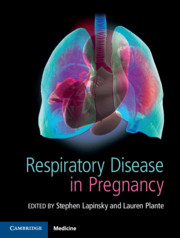Book contents
- Respiratory Disease in Pregnancy
- Respiratory Disease in Pregnancy
- Copyright page
- Contents
- Contributors
- Section 1 The Basics: for the Obstetrician
- Section 2 The Basics: for the Non-Obstetrician
- Section 3 Pulmonary Conditions Not Specific to Pregnancy
- Section 4 Pulmonary Conditions Related to Pregnancy
- Section 5 Other Pulmonary Issues in Pregnancy
- 19 Tobacco Smoking in Pregnancy
- 20 Radiological Imaging of the Chest in Pregnancy
- 21 Respiratory Drug Therapy in Pregnancy
- 22 Biological and Immunosuppressive Respiratory Therapy in Pregnancy
- 23 Oxygen Therapy during Pregnancy
- 24 Airway Management in Pregnancy
- 25 Mechanical Ventilation in Pregnancy
- Index
- References
23 - Oxygen Therapy during Pregnancy
from Section 5 - Other Pulmonary Issues in Pregnancy
Published online by Cambridge University Press: 14 April 2020
- Respiratory Disease in Pregnancy
- Respiratory Disease in Pregnancy
- Copyright page
- Contents
- Contributors
- Section 1 The Basics: for the Obstetrician
- Section 2 The Basics: for the Non-Obstetrician
- Section 3 Pulmonary Conditions Not Specific to Pregnancy
- Section 4 Pulmonary Conditions Related to Pregnancy
- Section 5 Other Pulmonary Issues in Pregnancy
- 19 Tobacco Smoking in Pregnancy
- 20 Radiological Imaging of the Chest in Pregnancy
- 21 Respiratory Drug Therapy in Pregnancy
- 22 Biological and Immunosuppressive Respiratory Therapy in Pregnancy
- 23 Oxygen Therapy during Pregnancy
- 24 Airway Management in Pregnancy
- 25 Mechanical Ventilation in Pregnancy
- Index
- References
Summary
Oxygen was employed in the acute care setting for the first time in 1885; but it was not until the twentieth century that discoveries related to its physiological effects and technological advances enabled its clinical application.
- Type
- Chapter
- Information
- Respiratory Disease in Pregnancy , pp. 210 - 221Publisher: Cambridge University PressPrint publication year: 2020



